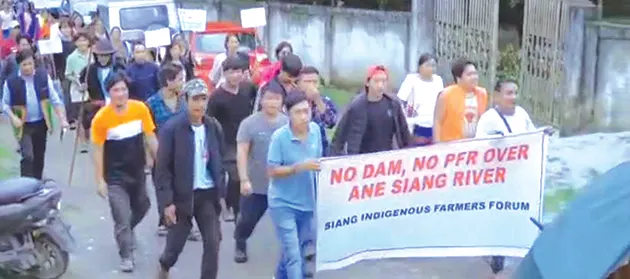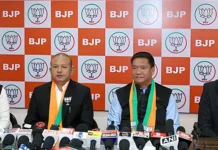[ Tongam Rina ]
ITANAGAR, 5 Oct: Siang Valley witnessed yet another protest against the proposed Upper Siang Multipurpose Storage Project as hundreds, unmindful of the rain, took to the streets in Geku, Upper Siang, on Saturday.
The Hydroelectric Project, which aims to generate over 11,000 mw of electricity from the Siang river, has been opposed by the villagers, who fear they will be forcefully displaced with the implementation of the project. This was the second protest following the one held at Dite Dime, one of the three proposed dam sites, on 31 August.
The protests have intensified as an NHPC team has been conducting a survey for the project’s feasibility report, albeit surreptitiously. The villagers captured videos of the survey being conducted by NHPC in the early hours to avoid detection by the protesting villagers.
In today’s protest, led by the Siang Indigenous Farmers’ Forum (SIFF), the villagers voiced their opposition to the National Hydroelectric Power Corporation (NHPC), saying “no” to surveys and “no” to the dam. They also protested against the elected representatives of Siang and Upper Siang – RWD Minister Ojing Tasing, who represents the Pangin-Boleng assembly constituency; Tuting-Yingkiong MLA Alo Libang; and Geku-Mariyang MLA Oni Panyang – and Chief Minister Pema Khandu. They also voiced their opposition against some of the members of Adi Bane Kebang (ABK), the apex body of the Adis. The SIFF accuses the ABK of consenting to the government’s proposal for conducting surveys for the proposed project.
In response to the allegation, ABK general secretary Vijay Taram had earlier said that “the ABK has not given any consent to the government for surveys. Instead, they have agreed to allow the government to prepare a pre-feasibility report to determine the potential of the land and analyse the feasibility of the project.”
As reported earlier, on 19 August, the Special Branch of the police headquarters directed the Pasighat branch to assess security threats related to the survey and core drilling for the project. The identified locations for drilling were Parong, Dite Dime, and Uggeng.
Earlier, on 16 September, the SIFF reiterated its objection to the proposal for preparing a pre-feasibility report for the proposed mega project during a consultative meeting organised by the All Riew Students’ Union. The meeting was attended by Rural Development Minister Ojing Tasing, SIFF members, and NHPC representatives.
However, it yielded no feasible outcome, as participants remained stuck to their respective stands.
As reported earlier, the Upper Siang and Siang district administrations had barred the gaon burahs, gaon buris, and other government employees from participating in these protests, provoking strong resentment among those opposed to the dam, who view this as clear intimidation. The Siang Valley, which has consistently opposed the damming of the Siang, is poised for further protests as citizens and the government hold differing views on the matter. While the government cites China’s proposal to build upstream of the Siang, those opposed to the dams legitimately fear being uprooted from their land.
While a representative of the NHPC was quoted as saying that China has already begun constructing a hydropower project on the Yarlung Tsangpo river with a massive 60 gw installed capacity, these claims have not been substantiated by the claimants, including the government of Arunachal Pradesh.
While more protests are likely to follow these two major demonstrations, yet there has been little or no reaction from the government in recent times, apart from stating that dams are essential for self-reliance and for countering China’s proposals for dam building on Tibet’s Yarlung Tsangpo river, which is upstream of the Siang.
The government’s initial plans for the Lower Siang HEP (2,700 mw) and the Siang Upper HEP Stage-II (3,750 mw had already faced resistance for more than two decades. Amid fears and opposition from the people, the capacity was expanded to 11,000 mw without new studies, triggering a fresh wave of protests.





